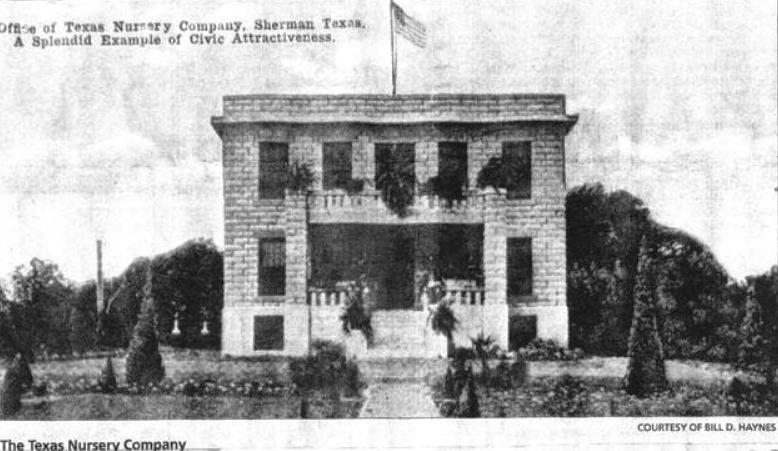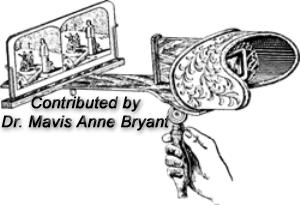|
Texas Nursery Sherman, Texas   The Texas Nursery Company
Plant. Most folks don't give
much thought to the trees, bushes, shrubs
and plants that grow all around them. They are part of the
landscape
and are just there. But in an urban environment, what grows
there
was usually plated there by someone, for some specific
purpose. And
the seed of the cutting that they planted came from a nursery.
This time of year particularly, when the cold wind blows and the sun hides behind ominous clouds, gardeners sit by the fire and peruse the seed catalogues. The pictures of flowers and long rows of trees heavy with fruit may brow only in their dreams, but those dreams help pass the time until they can get back into the dirt. For many years, those winter's dreams could have been nurtured by a catalogue from Sherman. For a time, from the turn of the last century until World War II. Sherman was home to one of the largest nurseries in the Southwestern United States - The Texas Nursery Company. As a smaller entity, it lasted until the 1900s. The company is gone now but it's living legacy can be seen in many of the trees and plants that enhance homes and schools and businesses in North Texas and beyond. Elbert W. Kirkpatrick founded the company in 1898, with C.C. Mayhew as the Texas Nursery and Floral Company. Already a nurseryman of some renown, Kirkpatrick had been in the business since 1874, when he started a business in White's Grove. He moved to McKinney in 1887, where he ran his own nursery and also presided over the affairs of the Whitesboro Orchard and Fruit Company and the Nueces Land and Immigration Company. Sherman's railroad connections and convenience of shipping to all parts of the Southwest caused Kirkpatrick to locate his new nursery here. The name was changed in 1902 to the Texas Nursery Company. In 1906, Kirkpatrick joined with John S. Kerr's Commercial Nursery and Orchard Company, also a McKinney concern, taking on Kerr as vice president of the operation. If it grew in Texas soil, Kirkpatrick, Kerr and Mayhew sold it. The company's headquarters were at the foot of Walnut Street in a building that now houses Mitchell Construction. The fields and farms extended south to Post Oak Creek and Southeast to Montgomery Street. Other farms sites were scattered about the county, most notably near Spout Springs northwest of Pottsboro. The nursery expanded to the Indian Territory and remnants of the operations are still seen north of Colbert, Oklahoma. The nursery shipped plants for wholesale all over the southwest and boasted a substantial retail business in the Sherman area. In 1924, Austin College celebrated its 75th anniversary. As part of a commemorative landscaping project, the Texas Nursery planted many oaks and sycamores that still shade the campus today. The new highway between Sherman and Denison, new, that is, is 1929, the highway that is now State Hwy 91, was planted with many of the company's sycamores, some of the trees, along the west of the current road, still stand. Hugh E. Hall, a family friend of the Mayhews, came to Sherman in 1901 as secretary-treasurer of the company. He also served as landscape architect and personnel manager. Although only nine when his father died, Clyde Hall recalls time spent at the nursery. "My brother and I were permitted to roam the grounds all the way to the creek. On Saturday nights we were always present for "payday", when my father would pay of the workers. We'd spend the evening sliding down the rails alongside the stairsteps. "We lived on south Travis, some four blocks from the nursery. Whenever we heard the fire engines, the entire family became excited, fearful that the huge barn or warehouse that stood about a block east of the headquarters might be on fire." Hall also recalls another fire and his father's concern for the safety of some of the company's black employees. "When the courthouse was burned by the mob in 1930, my father took my brother and me down to watch the fire from the southeast corner of the square. When he saw the mob cutting the fire hoses, he got us out of there in a hurry, sending the family to my grandfather's home in Van Alstyne. "He came back to Sherman and rounded up 20 or more of his workers and their families and took them to our house. I proved a safe haven from the mobs that were turning and terrorizing black people in the city." Viola Fulencheck Dutton worked on the Texas Nursery far north of Pottsboro in the years before WWII, and she wrote of her experiences in the History of Grayson County Texas, Volume II, published by Grayson County Frontier Village in 1981. "Around 75 people worked at the nursery at one time. They lived in houses and tents in the area. Field hands made 10 cents an hour and shop hands made 15 cents. Most worked a ten-hour day. Hands got paid once a month and could buy groceries at a company store at the nursery. "There were 16 mules, eight pulled the digger that dug up plants for shipping and the other eight hauled he plants and shrubs back to the shipping shed. The main plants were wisteria and crepe myrtle. We also grew English walnut trees. "To prepare the plants for shipping, they were put in bundles called 10/25s. That meant ten big plants and 25 small ones." At one time the company was the number one provider of crepe myrtle plants in the country and their horticulturists developed new and colorful strains of that popular ornamental bush. They sold pecan trees and berry bushes and flowers from a retail floral shop run by Walter Carpenter: That building, too, still stands, 100 yards southeast of the headquarters, serving now as a small church. Kirkpatrick, the company's founder, died in 1924; Kerr followed in 1925. The depression of the "30s slowed the company's business and other factors - perhaps a less aggressive attitude than that exhibited by the early management - also contributed. A smaller operation continued after the war and as late as the early 1960s the company was still putting out a sizable catalog and offering plants to growers as far north as Kansas and Missouri. The company was proud of its products and proud of the trust earned from the people who bought them, as this excerpt from a customer's letter shows. "All the tress I bought from you three years ago came true to name and were fine trees. This is my reason for wanting trees from you again. I bought some trees from (a competitor) also some from (another rival). They did not come true to name and were of no value to me. I cut them down and cast them out of my orchard. I have the largest and finest orchard in western Tennessee."  Texas Nursery History Flora & Fauna Susan Hawkins © 2024 If you find any of Grayson County TXGenWeb links inoperable, please send me a message. |